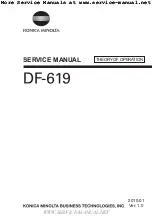
44
DSM300 Installation Manual
Be sure the top of the isolation sleeve will be below the top of the backing
block to prevent the sleeving from interfering with tightening the hull nut.
CAUTION:
To prevent electrolytic corrosion, never allow direct contact
between a stainless steel transducer and a metal hull.
3. Apply a 1/16" (2mm) thick layer of marine sealant to the sides of the trans-
ducer that will contact the fairing, if used, and up the stem 1/4" (6mm) higher
than the combined thickness of the fairing, hull, backing block, and hull nut.
This will ensure there is marine sealant in the threads to seal the hull and hold
the hull nut securely in place (see Figure 2-13 ).
Stainless steel transducer in metal hull - Apply the marine sealant to the out-
side of the sleeving instead of the stem itself.
4. If a fairing is used, thread the transducer cable through the fairing and seat
the transducer firmly within the recess in the fairing.
5. Apply a 1/16" (2mm) thick layer of marine sealant to the surface of the fairing
that will contact the hull, if used.
Attaching the Transducer
1. From outside the hull, thread the cable through the mounting hole.
2. Push the stem of the transducer (with the fairing in place) into the mounting
hole using a twisting motion to squeeze out excess sealant.
3. From inside the hull, slide the backing block onto the transducer cable and
stem, seating it firmly against the hull (Figure 2-15 ).
CAUTION:
Be careful to avoid cross threading the cap nut.
4. Screw the hull nut in place and tighten it with slip-joint pliers.
Stainless steel transducer in metal hull - Be sure the top of the isolation sleeve
is below the top of the backing block to prevent the sleeving from interfering
with tightening the hull nut.
5. Apply a 1/16" (2mm) thick layer of marine sealant to the anti- rotation bolt,
1/4" (6mm) higher than the combined thickness of the fairing, hull, backing
block, washer, and nut. This will ensure that there is marine sealant on the
threads to seal the hull and hold the nut securely in place (see Figure 2-14 ).
6. Push the bolt through the fairing, if used, and into the hull.
7. From inside the hull, slide the washer and nut onto the bolt. Screw the nut in
place and tighten it with slip-joint pliers.
Wood hull - Allow for the wood to swell.
















































